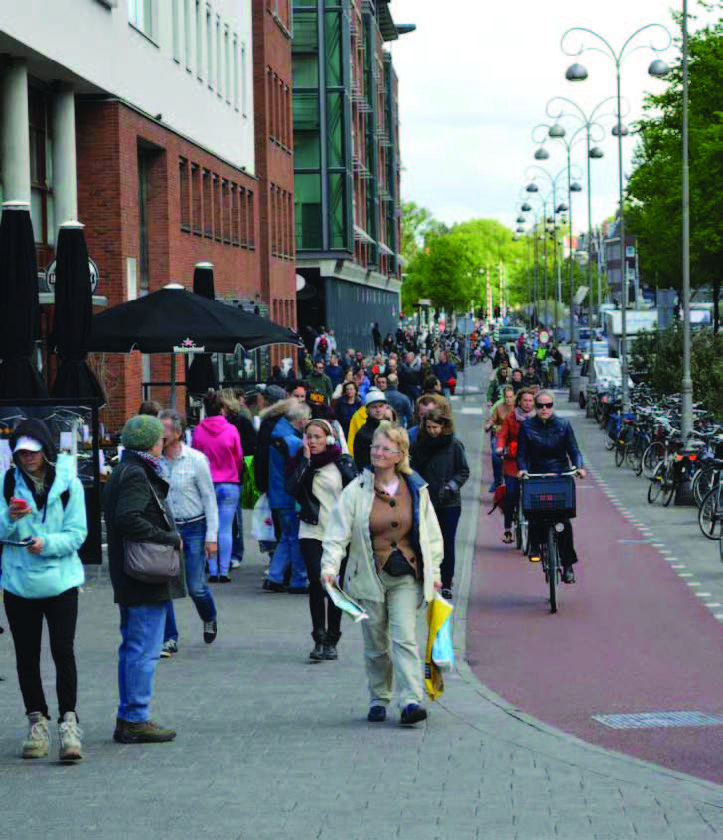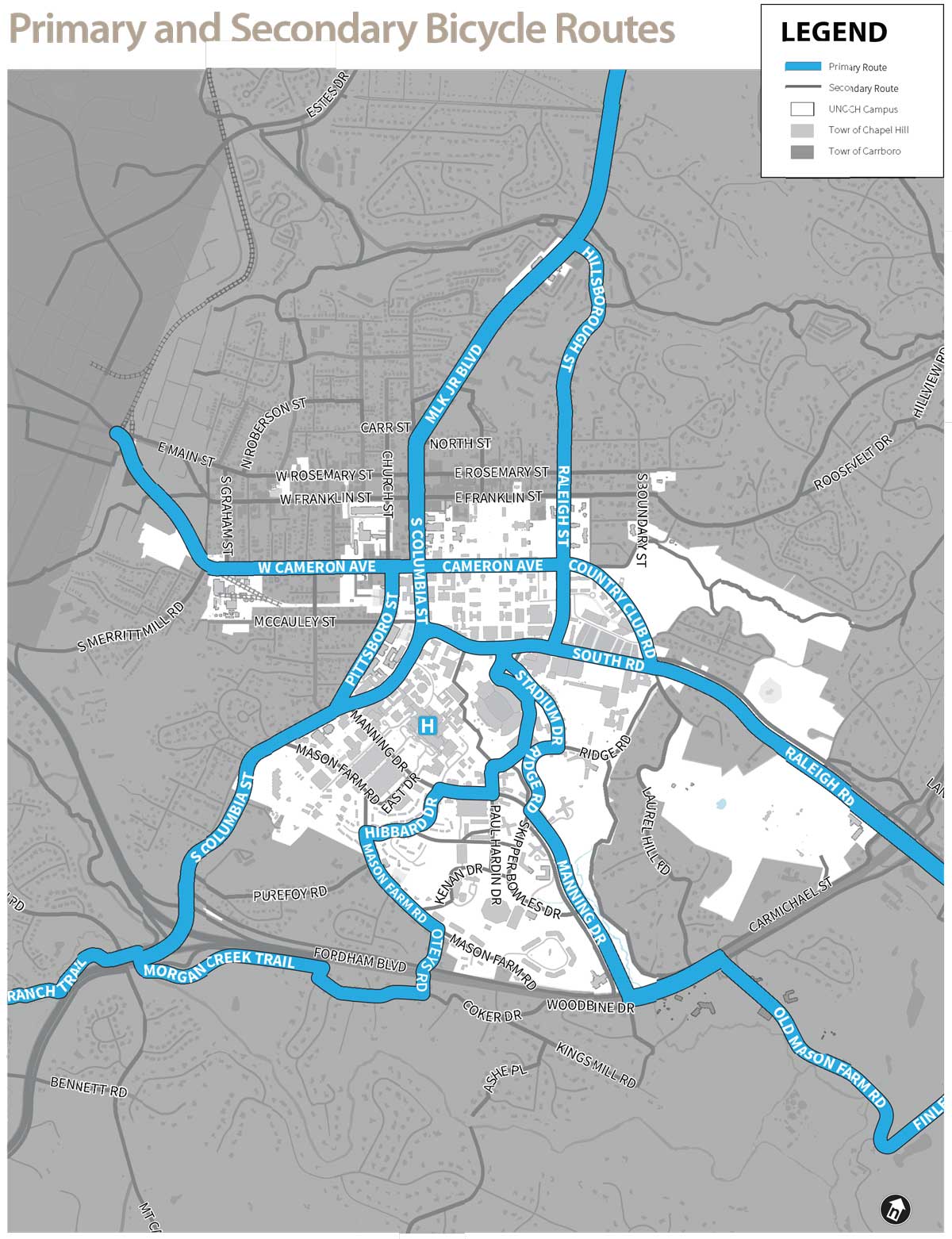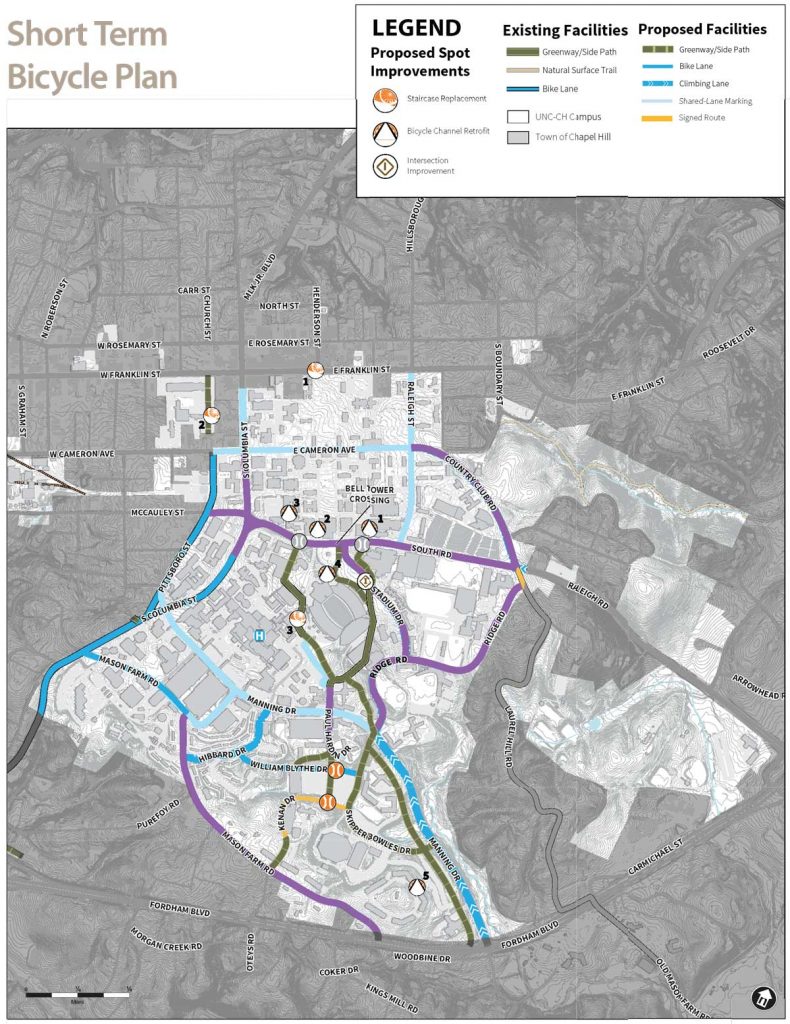Chapter 3: Engineering Recommendations – Bicycle Network
As discussed in Chapter 2, there are a number of challenges for bicyclists traveling to and through campus. This chapter provides an overview of the proposed UNC-CH bicycle network. The proposed UNC-CH bicycle network will consist of a series of easily identifiable primary and secondary bicycle routes that are seamlessly connected to the Town bicycle network. The routes are intended to be designated on maps and with wayfinding signs.
Each route follows various combinations of individual roadway, pathway and parking lot segments that presently exist or are proposed as future projects. To promote safety and use of these routes, this plan recommends physical changes to portions of each route to mitigate common challenges bicyclists experience where appropriate. Improvements are categorized as short term or long-term depending upon the degree of complexity and potential construction cost. For many long-term recommendations, there are multiple options which will require further evaluation before a preferred option is selected. Appendix C defines the engineering treatments proposed to improve the routes and provides reference to applicable design guidelines and standards governing the installation and operation of those treatments. Appendix D provides detailed descriptions of the existing conditions, short- and long-term recommendations, implementation challenges and improvement costs for individual segments which comprise each bicycle route.
Implementation of this plan will require cooperation and coordination between the University, the Town and NCDOT. Many of the streets and proposed routes within the UNC-CH campus are primarily maintained by the Town or NCDOT, thus changes to those streets will require their support. Additional flexibility may be available for recommendations which may require relocation of curbs or reconstruction of sidewalks where the adjacent property is owned by UNC-CH, but there are instances where the property is privately held or owned by either the Town or NCDOT. Within Campus, UNC-CH has sole authority to implement changes proposed on Stadium Drive, Hibbard Drive, William Blythe Drive, Kenan Drive, and Skipper Bowles Drive. Strategies necessary to implement and fund these projects are included in Chapter 6.
To manage conflicts between pedestrians and bicyclists, other universities have implemented bicycle dismount zones with varying degrees of success for all or part of the day. Examples include:
| Institution | Hours of Restriction | Location | Enforcement |
|---|---|---|---|
| University of Washington | 24 hours | Core | $25 ticket |
| University of California – Berkeley | 8 a.m.-6 p.m. | Select crossings | Citation |
| University of Oregon | 24 hours | Core | $30 ticket |
Based on discussions with staff and observations of dismount zones at universities with this policy, the effectiveness of a bicycle dismount zone (or walk zone) varies from campus to campus based on a number of factors including: enforcement, size of zone, availability and proximity of alternative routes, bicycle parking, security and time of day. Last and not least, the overall campus culture plays a major role. Feedback through the UNC-CH bike plan public process indicates there is concern with conflicts between pedestrians and bicyclists on north campus, but there is not support from the biking community for a mandatory dismount zone.
Dismount Zone Recommendations
It is not recommended the University implement a dismount zone in the short term. It is recommended the University undertake the following three actions:
- Provide additional bicycle parking around the perimeter of North Campus (see Chapter 4).
- Track pedestrian/bicycle conflicts within North Campus.
- Implement education and enforcement strategies to change behavior (see Chapter 5).
If after these recommendations are implemented and pedestrian/bicycle conflicts are documented to occur on a regular basis, it may be necessary to reconsider the dismount zone. If pursued, limit the dismount zone to the area where safety issues persist during peak periods of pedestrian activity.
The development of the primary and secondary bicycle route network is based on the recommendation to not pursue a dismount zone. Additionally, given the density of sidewalk and alley options on North Campus combined with the diverse origins and destinations of bicyclists, bicycle routes will not be designated or signed within the boundaries of North Campus. Bicyclists will enjoy full access to all of the sidewalks, parking lots and streets within North Campus.
 It is recommended wayfinding signs be installed on all primary and secondary routes. The design and installation of the wayfinding signs should be coordinated with the Town to ensure a uniform approach is developed to guide sign design and installation across jurisdictional boundaries. To simplify coordination, the use of a combination of MUTCD 1 D1 and D11 series signs is recommended. Customized graphics could be developed for use on the D11 sign. At a minimum, the signs should provide destination information with confirmation arrows. Supplemental signs directing bicyclists to locations with bicycle parking can be valuable where the parking is not readily visible such as in parking decks. M1 series signs may supplement the D series signs to identify the United States Bicycle Route 1 route which traverses Cameron Avenue and Country Club Road.
It is recommended wayfinding signs be installed on all primary and secondary routes. The design and installation of the wayfinding signs should be coordinated with the Town to ensure a uniform approach is developed to guide sign design and installation across jurisdictional boundaries. To simplify coordination, the use of a combination of MUTCD 1 D1 and D11 series signs is recommended. Customized graphics could be developed for use on the D11 sign. At a minimum, the signs should provide destination information with confirmation arrows. Supplemental signs directing bicyclists to locations with bicycle parking can be valuable where the parking is not readily visible such as in parking decks. M1 series signs may supplement the D series signs to identify the United States Bicycle Route 1 route which traverses Cameron Avenue and Country Club Road.
1 The Manual on Uniform Traffic Control Devices (MUTCD) is the national standard for roadway and pathway signage and markings.
The improvement used will be determined mostly by the existing road width. Bicycle lanes, which create a separate space for the bicyclists to travel on both sides of a roadway are preferred. However, where there is not room for separate bike lanes in both directions and there are steep slopes, a climbing lane is recommended. The climbing lane is a separate bike lane only on the uphill side of a roadway. This separated lane allows bicycles to travel safely uphill without impeding vehicular traffic lanes. Where there is no room for either bike lanes, or a climbing lane, marked shared lanes can be used. The marking of the lane as a shared use lane consists of a symbol placed in the center of the lane to indicate that this roadway is a shared use facility for both vehicles and bicycles. The symbol is repeated at regular intervals. The shared lane markings primarily are used as a tool to raise awareness that both bicycles and vehicles should share the road.
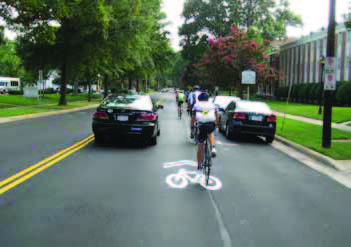
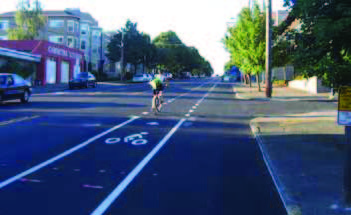
- West side of Graham Student Union
- East side of Caudill Labs
- East Side of Kenan Labs
- North side of Kenan Stadium
- Baity Hill Student Family Housing
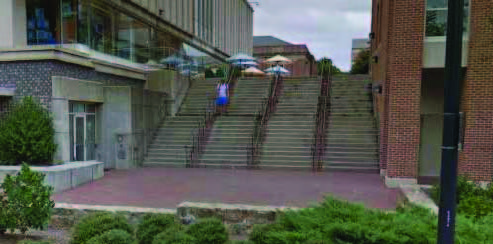
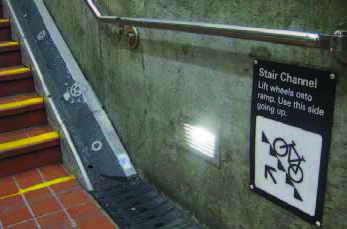
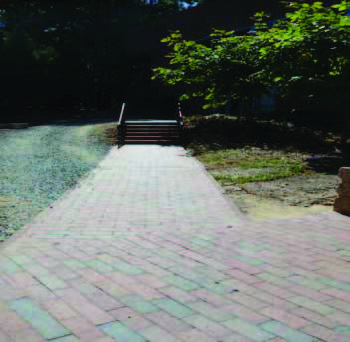
There are three additional locations where relatively short staircases impede bicycle travel through campus on priority bicycle routes. It is recommended these staircases be replaced with American with Disabilities Act (ADA)-compliant accessible ramps. The location of these ramps are at key transitions between the campus and the staircases at the following locations:
- Staircase approaching the eastern eastern Franklin Street crosswalk at Henderson Street from McCorkle Place
- Staircase connecting Fraternity Court to University Square
- Staircase adjacent to Campus Health Services.
In the event it is determined that the staircases cannot be replaced with ADA-accessible ramps, consideration should be given to constructing bicycle ramps adjacent to the existing staircases. A bicycle ramp creates a barrier free route intended only for bicycle travel and thus does not have to be constructed to the maximum slopes required to meet ADA guidelines. It can thus be constructed at a steeper slope to fit into the existing terrain adjacent to the staircase. As able bodied pedestrians are likely to use this ramp, it is recommended not to exceed a maximum ramp slope of ten percent.
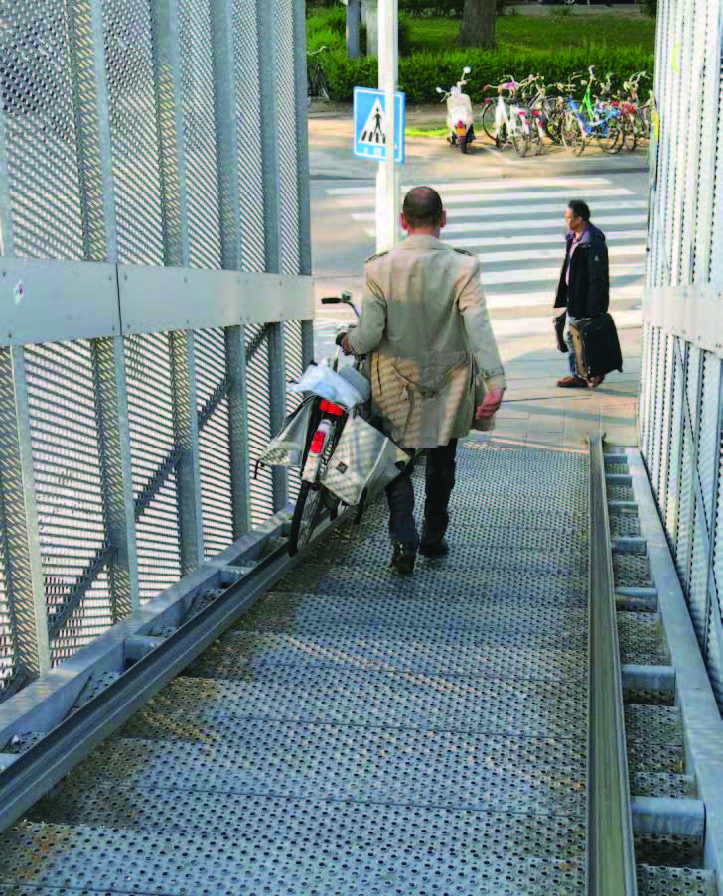
The long-term bicycle network was developed to guide the implementation of the campus master plan, which envisions new campus buildings, roadways and paths, as well as redevelopment of some existing buildings. The long-term recommendations are expected to be higher cost and will require reconstruction of roadways, installation of new paths and reconfiguration of parking. The locations for the improvements described below are depicted on the long-term map (see Figure 13) and in Appendix D with additional detail.
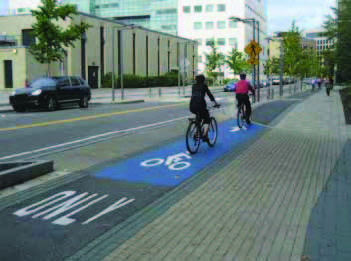
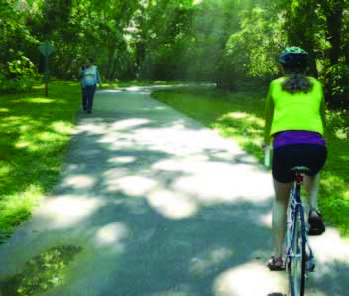
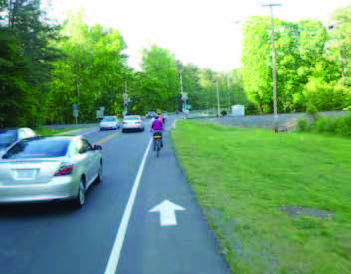
- Provision of additional crossing time (walk time or green time) where no conflicting movements occur or time can be reallocated from a lower demand movement (example Cameron Avenue at South Columbia Street).
- Provision of leading bicycle/pedestrian interval to reduce conflicts with turning traffic at signalized intersections (example Raleigh Street at Franklin). This would require bicycle signals at locations where the bicyclists are traveling in the roadway.
- Reductions of curb radii to slow turning traffic (example Raleigh Road at South Road).
- Widening of curb ramps on paths and sidewalks (example South Road at South Cameron Avenue).
- Provision of actuated warning signs such as a Rapid Flashing Beacon (example Stadium Drive at East Kenan Connector Path).
- Provision of automatic recall walk signals will result in the walk signal being triggered each cycle change of the traffic signal. This will ensure adequate crossing time is provided to pedestrians and bicyclists who operate on sidewalks and would not normally push the button (example Raleigh Street at Franklin Street).
- Provision of pedestrian signals for all directions crosswalks should be located to ensure adequate information is provided to pedestrians and bicyclists who travel on sidewalks (example Fordham Boulevard at Manning Drive).
